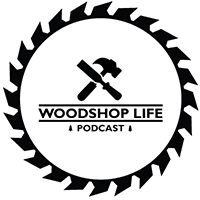Brian’s Questions:
Hey guys,
First of all, thanks for the most helpful woodworking podcast around! My question(s) revolve around a home library project. I’m planning on bookcases on all four walls of a small room and wondering how you’d approach that, specifically:
(1) what would you do about the inside corners of the room where two sets of bookcases come together? Just blank them off? Something else?
(2) as far as the cases themselves, for cost reasons, I’m planning to do 3/4 plywood carcasses close to 8’ high with one fixed shelf in the middle (Domino construction) and shelf pins for the rest of the shelves. How wide can I reasonably go without sag in the shelves? Is one fixed shelf enough for stability or do I need two, say? Do I need a plywood back on each case?
Any other general tips on a library project or this type?
Thanks! Mat
What tools you guys do regret to buy?
Marcello
Alright fellas first question from me. I finally got a Makita track saw and went for the full 110″. I’m going to tear down my old 2×4 oversized work bench and start over with a nice miter saw / work area cabinet wall.
My plan is to go about 30″ deep to accommodate my DeWalt sliding dual bevel giant miter saw while also giving me ample assembly area. Maybe an mft style work area on one side, maybe t tracks here and there.
I’m going to leave it a little open ended for you guys to play around with the idea. What would your dream work area like this include? No limits, all the bells and whistles. No one to tell you no.
Thanks for taking my question. Jim G.
Huy’s Questions:
Hi Guys,
Really enjoy the podcast and all the useful information. I wrote before about a walnut table I am making. I have a couple of questions. I looked at the walnut at the local lumber yard. Great selection but lumber is pretty expensive. Question 1: The lumber distributor has a great selection. For the table top should I spring for quarter sawn at roughly 1/3 more per board foot? Question 2: I am trying to bring some order to chaos in my shop and am considering some shop cabinets. a) should I consider casters? b) should I spend the extra to install side mount drawer slides or will homemade runners be good enough?
Thanks for your help and the great podcast.
-Scott
Good day guys..My question is probably primarily for Huy.
I am getting back into woodworking after a lengthy hiatus to a career that did not allow me the time. Now that I do have the time, I am diving right back in. I am a lifelong contract mechanical designer, and have been a SolidWorks user/license holder since 1999, dont do the math on how much that has depleted my bank account in the past 24 years, and I am no rocket scientist like Huy, I have only done work on 70 ton vehicles designed outside detroit.
SolidWorks is amazing, and I have designed many projects for my woodworking with it. However I feel it is a bit heavyweight on the design side for the projects I want to do. I want to be working in my shop, and not spending hours designing parts, making assemblies etc. Dont get me wrong, the end results are incredible on the design side, but design for my woodworking shoudlnt be 60% on SolidWorks and 40% on tools. Any suggestions for the best solution for this? I have not spent alot of time researching, but have looked into Fusion360 and other solutions but not greatly as I know there will a thought process change required.
I am just looking for something simple, quick and of course accurate. We live in a 3d world, and that is an important aspect for me.Thank you so much.
Kurtis, DutchMillWorks
Hey guys, Josh here, hope this is the right way to contact you all. My question is, what machine do you think you can get away with in order to produce the most projects? I was thinking a lathe for drinkware, baseball bats and so on depending on a mini, midi or full size lathe. But I’m no expert by any means, I only had a couple years of shop experience in school and most of the terminology has escaped me since, but all the hands on experience is still fresh in my mind and I’m hoping to get this hobby started up again. Thank you. Joshua
